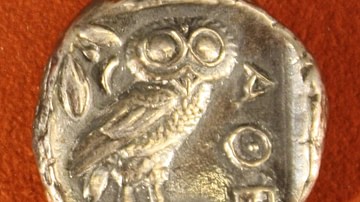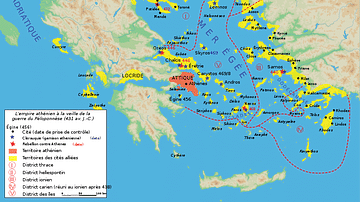Trade was a fundamental aspect of the ancient Greek world and following territorial expansion, an increase in population movements, and innovations in transport, goods could be bought, sold, and exchanged in one part of the Mediterranean which had their origin in a completely different and far distant region. Food, raw materials, and manufactured goods were not only made available to Greeks for the first time but the export of such classics as wine, olives, and pottery helped to spread Greek culture to the wider world.
From Local to International Trade
In Greece and the wider Aegean, local, regional, and international trade exchange existed from Minoan and Mycenaean times in the Bronze Age. The presence, in particular, of pottery and precious goods such as gold, copper, and ivory, found far from their place of production, attests to the exchange network which existed between Egypt, Asia Minor, the Greek mainland, and islands such as Crete, Cyprus, and the Cyclades. Trade lessened and perhaps almost disappeared when these civilizations declined, and during the so-called Dark Ages from the 11th to 8th centuries BCE international trade in the Mediterranean was principally carried out by the Phoenicians.
The earliest written sources of Homer and Hesiod attest to the existence of trade (emporia) and merchants (emporoi) from the 8th century BCE, although they often present the activity as unsuitable for the ruling and landed aristocracy. Nevertheless, international trade grew from 750 BCE, and contacts spread across the Mediterranean driven by social and political factors such as population movements, colonisation (especially in Magna Graecia), inter-state alliances, the spread of coinage, the gradual standardisation of measurements, warfare, and safer seas following the determination to eradicate piracy.

From 600 BCE trade was greatly facilitated by the construction of specialised merchant ships and the diolkos haulway across the isthmus of Corinth. Special permanent trading places (emporia), where merchants of different nationalities met to trade, sprang up, for example, at Al Mina on the Orontes river (modern Turkey), Ischia-Pithekoussai (off the coast of modern Naples), Naucratis in Egypt, and Gravisca in Etruria. From the 5th century BCE, Athens' port of Piraeus became the most important trading centre in the Mediterranean and gained a reputation as the place to find any type of goods on the market.
Traded Goods
Goods which were traded within Greece between different city-states included:
- cereals
- wine
- olives
- figs
- pulses
- eels
- cheese
- honey
- meat (especially from sheep and goats)
- tools (e.g.: knives)
- perfumes
- fine pottery, especially Attic and Corinthian wares.
Fine Greek pottery was also in great demand abroad and examples have been found as far afield as the Atlantic coast of Africa. Other Greek exports included wine, especially from Aegean islands like Mende and Kos, bronze work, olives and olive oil (transported, like wine, in amphorae), emery from Delos, hides from Euboea, marble from Athens and Naxos, and ruddle (a type of waterproofing material for ships) from Keos.
The goods available at the market places (agorai) of major urban centres which were imported from outside Greece included:
- wheat
- slaves from Egypt
- grain from the Black Sea (especially via Byzantium)
- salt fish from the Black Sea
- wood (especially for shipbuilding) from Macedonia and Thrace
- papyrus
- textiles
- luxury food such as spices (e.g.: pepper)
- glass
- metals such as iron, copper, tin, gold and silver.
Trade Incentives & Protection
Maritime loans enabled traders to pay for their cargoes and the loan did not have to be repaid if the ship failed to reach safely its port of destination. To compensate the lender for this risk, interest rates (nautikos tokos) could be from 12.5 to 30% and the ship was often the security on the loan.
The involvement of the state in trade was relatively limited; however, a notable exception was grain. For example, so vital was it to feed Athens' large population and especially valuable in times of drought, trade in wheat was controlled and purchased by a special 'grain buyer' (sitones). From c. 470 BCE the obstruction of the import of grain was prohibited, as was the re-exportation of it; for offenders the punishment was the death penalty. Market officials (agoranomoi) ensured the quality of goods on sale in the markets and grain had its own supervisors, the sitophylakes, who regulated that prices and quantities were correct.
Besides taxes on the movement of goods (e.g.: road taxes or, at Chalkedon, a 10% transit charge on Black Sea traffic payable to Athens) and levies on imports and exports at ports, there were also measures taken to protect trade. For example, Athens taxed those citizens who contracted loans on grain cargo which did not deliver to Piraeus or those merchants who failed to unload a certain percentage of their cargo. Special maritime courts were established to tempt traders to choose Athens as their trading partner, and private banks could facilitate currency exchange and safeguard deposits. Similar trading incentives existed on Thasos, a major trading-centre and large exporter of high quality wine.
With the decline of the Greek city-states in the late Classical period, international trade moved elsewhere; nevertheless, many Greek cities would continue to be important trading centres in Hellenistic and Roman times, especially Athens and the free-trade ports of Delos and Rhodes.






